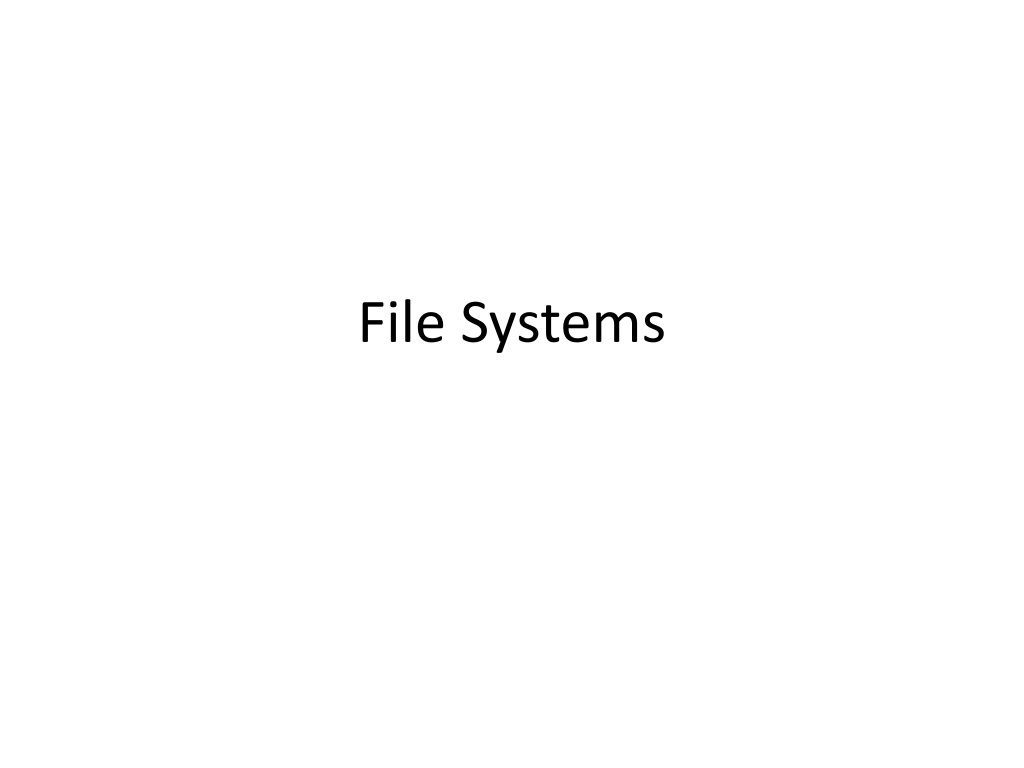File System Design Challenges and Options
Exploring the complexities of file system design, this content delves into various aspects such as file layout, design constraints, data structures, design challenges, options like FAT, FFS, NTFS, and more. It discusses the challenges of locating file blocks, index granularity, free space management, spatial locality preservation, and reliability in case of system crashes. The content also touches on named data in file systems and specifics of Microsoft's FAT.
Download Presentation

Please find below an Image/Link to download the presentation.
The content on the website is provided AS IS for your information and personal use only. It may not be sold, licensed, or shared on other websites without obtaining consent from the author.If you encounter any issues during the download, it is possible that the publisher has removed the file from their server.
You are allowed to download the files provided on this website for personal or commercial use, subject to the condition that they are used lawfully. All files are the property of their respective owners.
The content on the website is provided AS IS for your information and personal use only. It may not be sold, licensed, or shared on other websites without obtaining consent from the author.
E N D
Presentation Transcript
Main Points File layout Directory layout
File System Design Constraints For small files: Small blocks for storage efficiency Files used together should be stored together For large files: Contiguous allocation for sequential access Efficient lookup for random access May not know at file creation Whether file will become small or large
File System Design Data structures Directories: file name -> file metadata Store directories as files File metadata: how to find file data blocks Free map: list of free disk blocks How do we organize these data structures? Device has non-uniform performance
Design Challenges Index structure How do we locate the blocks of a file? Index granularity What block size do we use? Free space How do we find unused blocks on disk? Locality How do we preserve spatial locality? Reliability What if machine crashes in middle of a file system op?
File System Design Options FAT FFS NTFS Index structure Linked list Tree Tree (fixed, assym) (dynamic) granularity block block extent free space allocation FAT array Bitmap (fixed location) Block groups + reserve space Bitmap (file) Locality defragmentation Extents Best fit defrag
Microsoft File Allocation Table (FAT) Linked list index structure Simple, easy to implement Still widely used (e.g., thumb drives) File table: Linear map of all blocks on disk Each file a linked list of blocks
FAT Pros: Easy to find free block Easy to append to a file Easy to delete a file Cons: Small file access is slow Random access is very slow Fragmentation File blocks for a given file may be scattered Files in the same directory may be scattered Problem becomes worse as disk fills
Berkeley UNIX FFS (Fast File System) inode table Analogous to FAT table inode Metadata File owner, access permissions, access times, Set of 12 data pointers With 4KB blocks => max size of 48KB files
FFS inode Metadata File owner, access permissions, access times, Set of 12 data pointers With 4KB blocks => max size of 48KB files Indirect block pointer pointer to disk block of data pointers Indirect block: 1K data blocks => 4MB (+48KB)
FFS inode Metadata File owner, access permissions, access times, Set of 12 data pointers With 4KB blocks => max size of 48KB Indirect block pointer pointer to disk block of data pointers 4KB block size => 1K data blocks => 4MB Doubly indirect block pointer Doubly indirect block => 1K indirect blocks 4GB (+ 4MB + 48KB)
FFS inode Metadata File owner, access permissions, access times, Set of 12 data pointers With 4KB blocks => max size of 48KB Indirect block pointer pointer to disk block of data pointers 4KB block size => 1K data blocks => 4MB Doubly indirect block pointer Doubly indirect block => 1K indirect blocks 4GB (+ 4MB + 48KB) Triply indirect block pointer Triply indirect block => 1K doubly indirect blocks 4TB (+ 4GB + 4MB + 48KB)
FFS Asymmetric Tree Small files: shallow tree Efficient storage for small files Large files: deep tree Efficient lookup for random access in large files Sparse files: only fill pointers if needed
FFS Locality Block group allocation Block group is a set of nearby cylinders Files in same directory located in same group Subdirectories located in different block groups inode table spread throughout disk inodes, bitmap near file blocks First fit allocation Small files fragmented, large files contiguous
FFS Pros Efficient storage for both small and large files Locality for both small and large files Locality for metadata and data Cons Inefficient for tiny files (a 1 byte file requires both an inode and a data block) Inefficient encoding when file is mostly contiguous on disk (no equivalent to superpages) Need to reserve 10-20% of free space to prevent fragmentation
NTFS Master File Table Flexible 1KB storage for metadata and data Extents Block pointers cover runs of blocks Similar approach in linux (ext4) File create can provide hint as to size of file Journalling for reliability Next chapter
Directory Layout Directory stored as a file Linear search to find filename (small directories)

